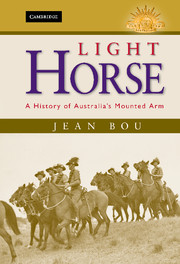Book contents
- Frontmatter
- CONTENTS
- List of maps
- ACKNOWLEDGEMENTS
- AUTHOR'S NOTE
- ABBREVIATIONS
- INTRODUCTION
- CHAPTER 1 ANCESTORS
- CHAPTER 2 TOUGH LESSONS
- CHAPTER 3 THE HUTTON ERA
- CHAPTER 4 UNFULFILLED PROMISE
- CHAPTER 5 THE LIGHT-HORSEMEN 1
- CHAPTER 6 MOUNTED RIFLES
- 7 CAVALRY
- CHAPTER 8 THE LIGHT-HORSEMEN 2
- CHAPTER 9 THE FINAL YEARS
- CONCLUSION
- EPILOGUE
- APPENDIX THE ‘BEERSHEBA CHARGE PHOTO’
- Notes
- BIBLIOGRAPHY
- INDEX
INTRODUCTION
Published online by Cambridge University Press: 05 July 2014
- Frontmatter
- CONTENTS
- List of maps
- ACKNOWLEDGEMENTS
- AUTHOR'S NOTE
- ABBREVIATIONS
- INTRODUCTION
- CHAPTER 1 ANCESTORS
- CHAPTER 2 TOUGH LESSONS
- CHAPTER 3 THE HUTTON ERA
- CHAPTER 4 UNFULFILLED PROMISE
- CHAPTER 5 THE LIGHT-HORSEMEN 1
- CHAPTER 6 MOUNTED RIFLES
- 7 CAVALRY
- CHAPTER 8 THE LIGHT-HORSEMEN 2
- CHAPTER 9 THE FINAL YEARS
- CONCLUSION
- EPILOGUE
- APPENDIX THE ‘BEERSHEBA CHARGE PHOTO’
- Notes
- BIBLIOGRAPHY
- INDEX
Summary
The mounted soldier is perhaps one of the most evocative symbols in Australian military history. Although by no means negligible, the military achievements of such men were restricted largely to the veld of South Africa, the trenches of Gallipoli and, more famously, the sands of the Sinai and the rocky hills of Palestine. In purely military terms the contribution of the Australian light horse to the general victory in the First World War seems relatively minor compared to the efforts of the Australian Imperial Force (AIF) fighting on the Western Front. There the Australian Corps took part in some of the largest battles of the war and played its part in the final battles that brought Germany to seek an armistice. By comparison the campaign in the Middle East was something of a strategic backwater, but it was a seemingly cleaner and less vicious war in which the front line moved, battles produced more than long casualty lists, and bravery and boldness might still, in the minds of many, as evidenced by Beersheba and other battles, sway the day. The men who fought on the Western Front have hardly been forgotten, but it was the actions of their mounted military compatriots in the Palestine theatre that, when combined with a continuing romantic ideal of mounted soldiers, has gone on to capture a remarkable place in the collective memory.
For many students of Australian military history the quintessential Australian soldier (in as much as such a person exists) of the First World War might be thought of as the ‘digger’, the infantryman who fought at Gallipoli or the Western Front. There is much to be said for this view, and it is certainly the case that the battles such men fought and the conditions they endured are among the most examined aspects of Australia's military heritage; the number of books about them grows each year. Yet an examination of popular representations of Australian soldiers of the First World War produces an intriguing result: that the memory of the light horse and the light-horseman has found a number of manifestations that no other arm of the Australian Army, including the infantrymen of Gallipoli and the Western Front, has come close to matching.
- Type
- Chapter
- Information
- Light HorseA History of Australia's Mounted Arm, pp. 1 - 12Publisher: Cambridge University PressPrint publication year: 2009

